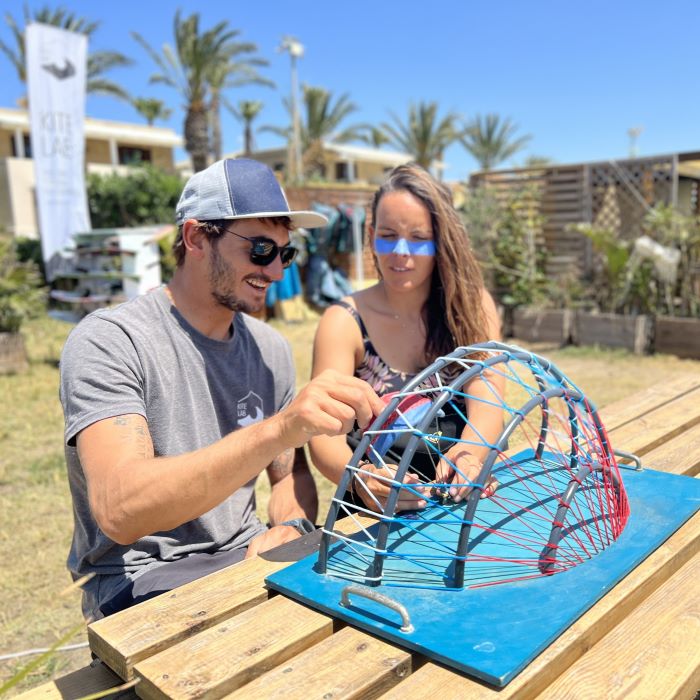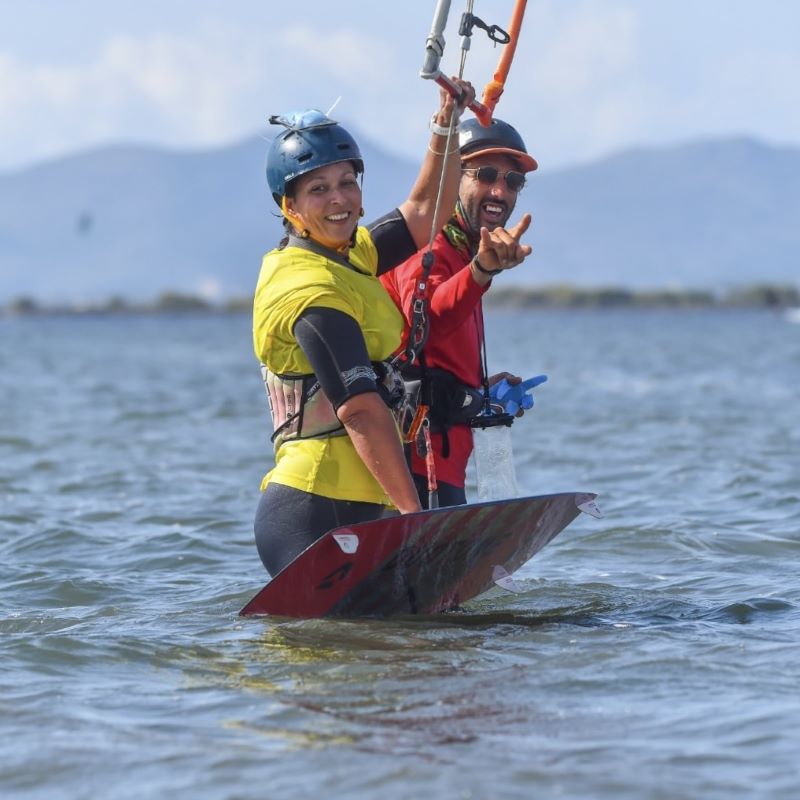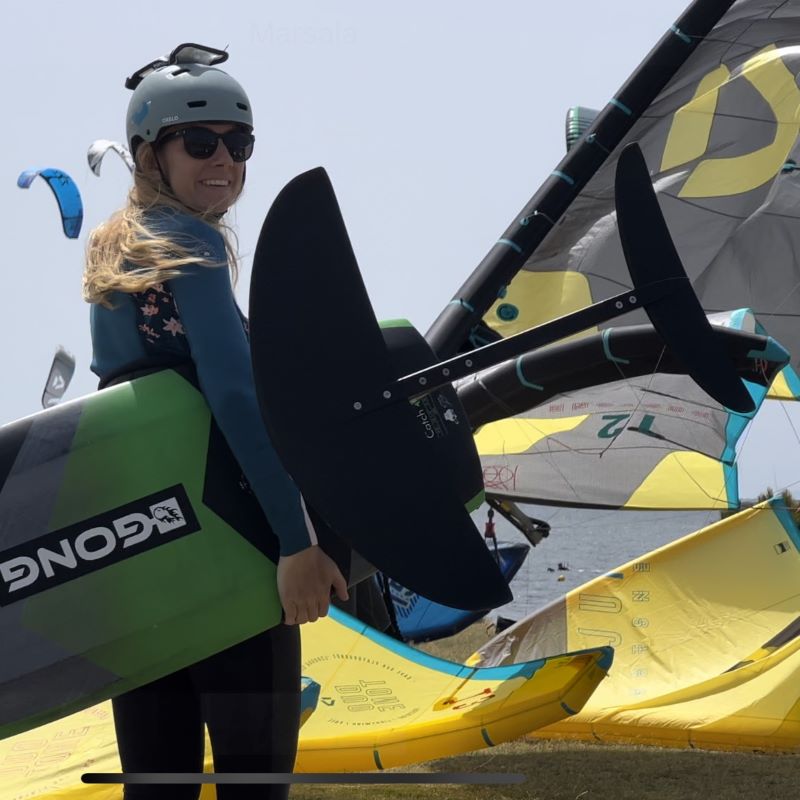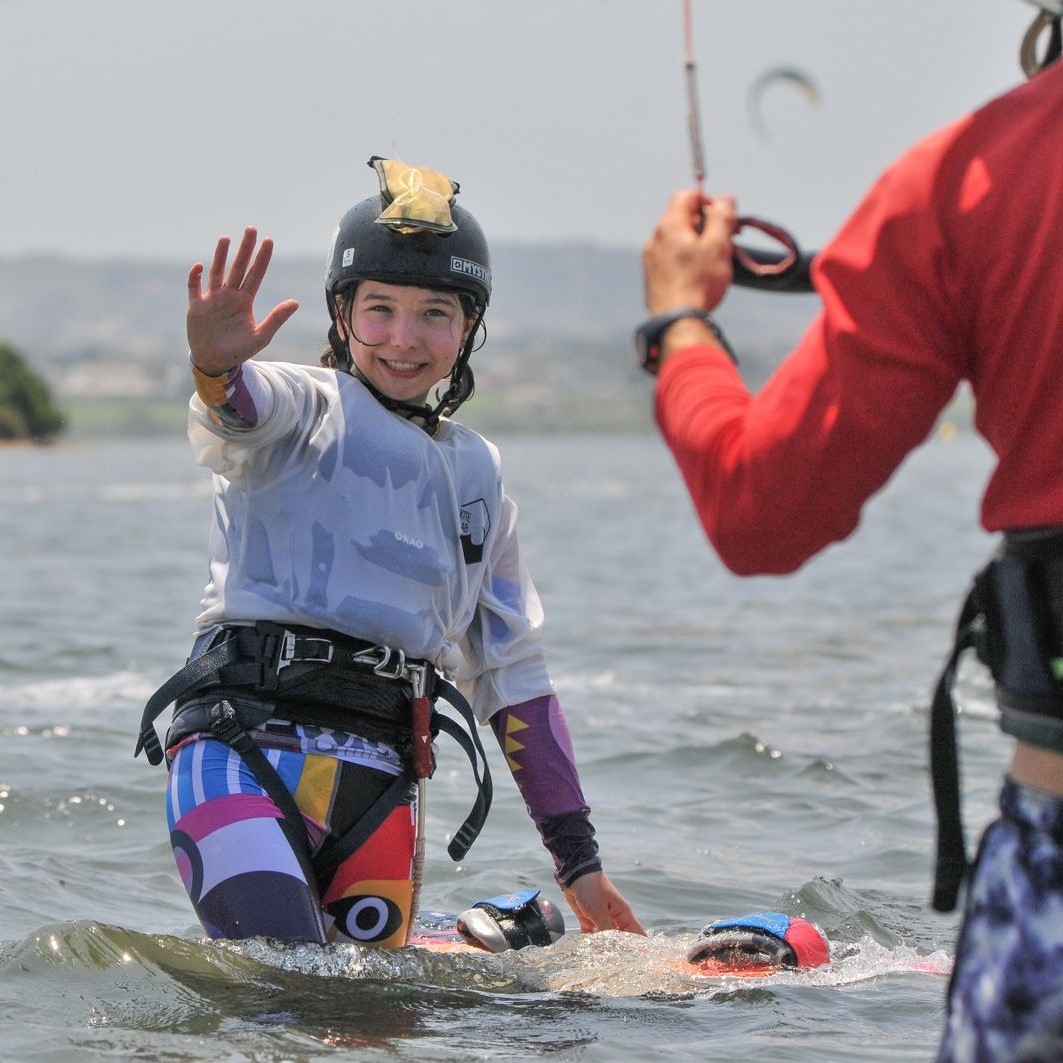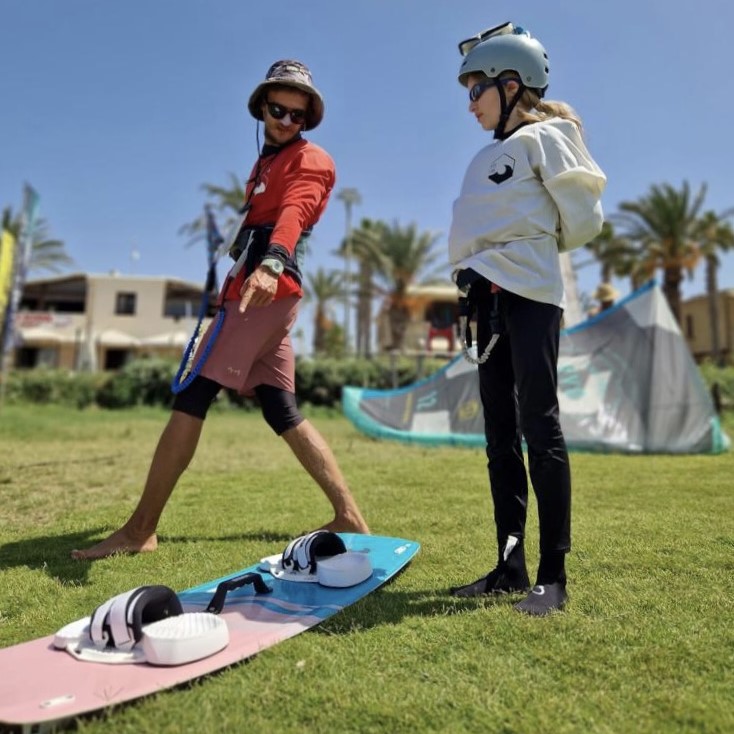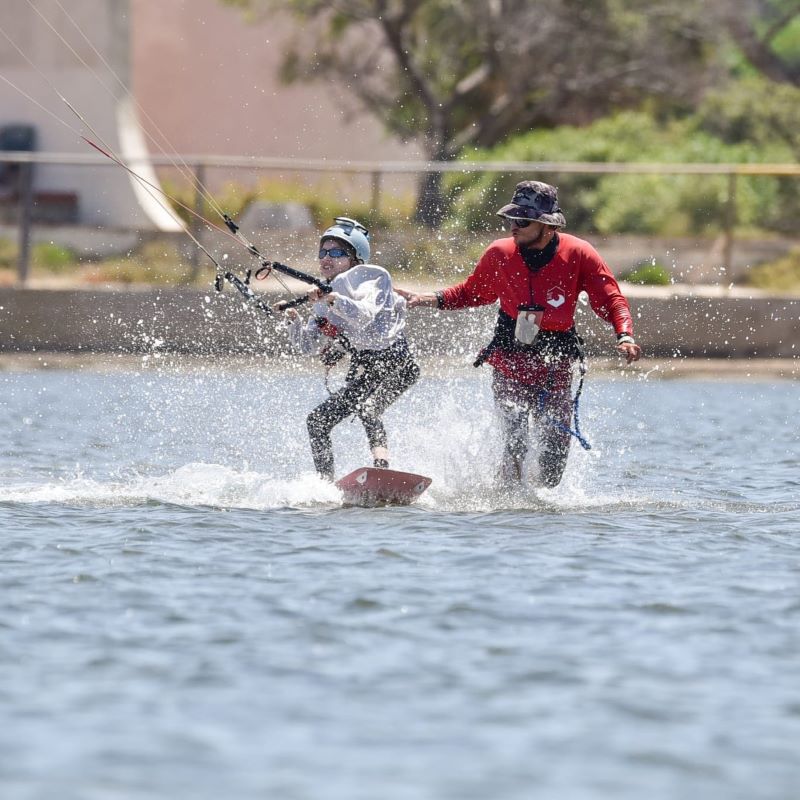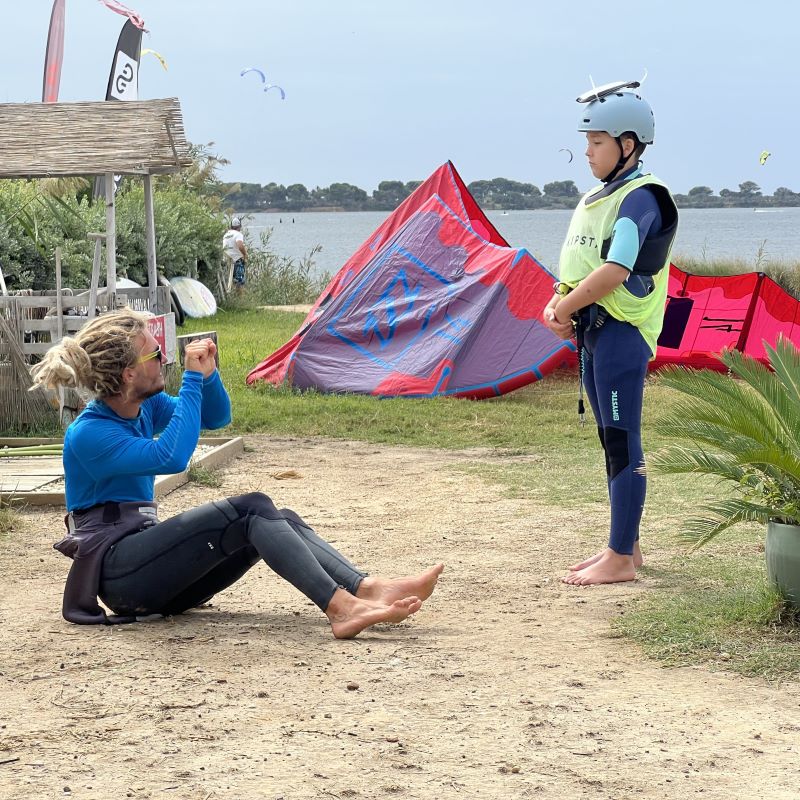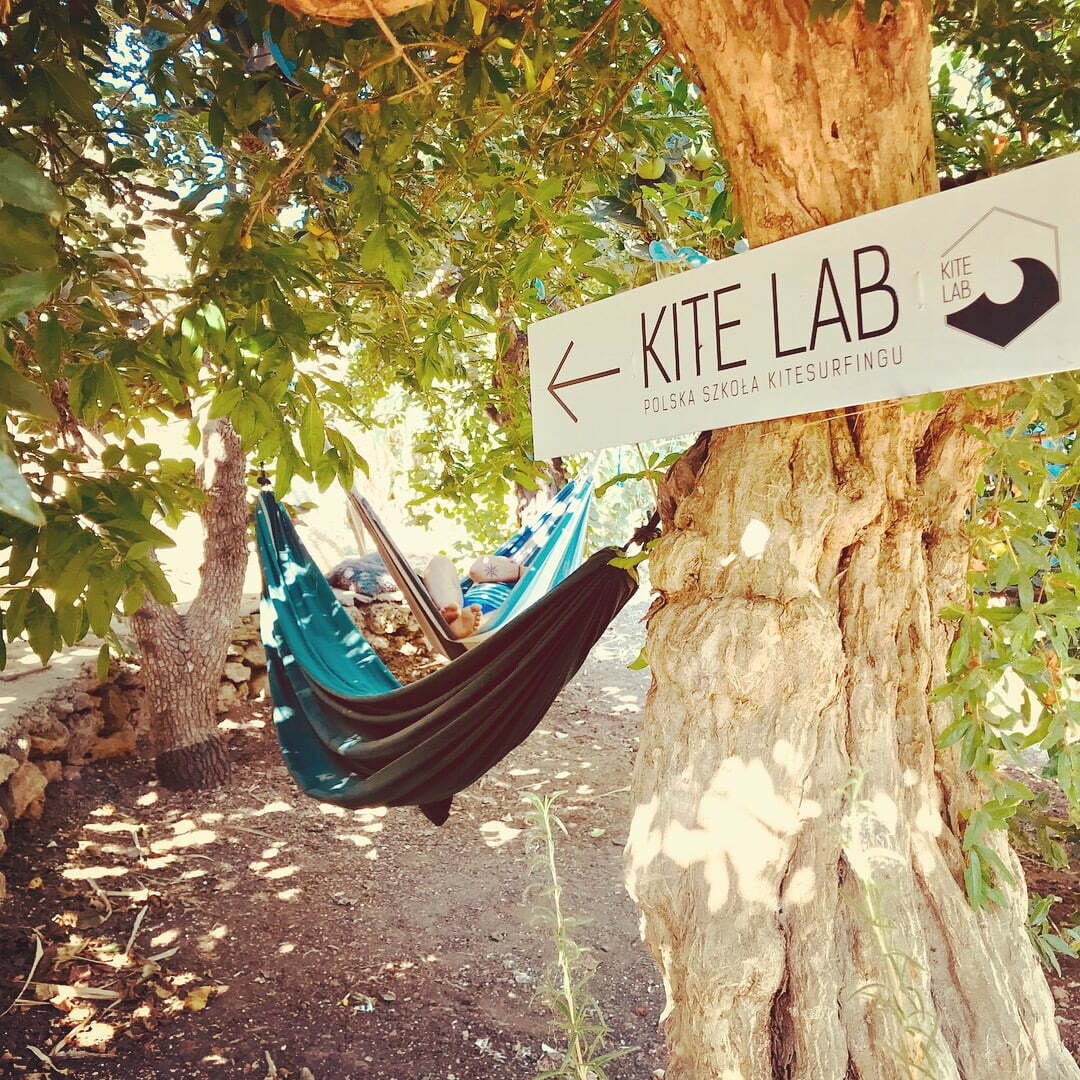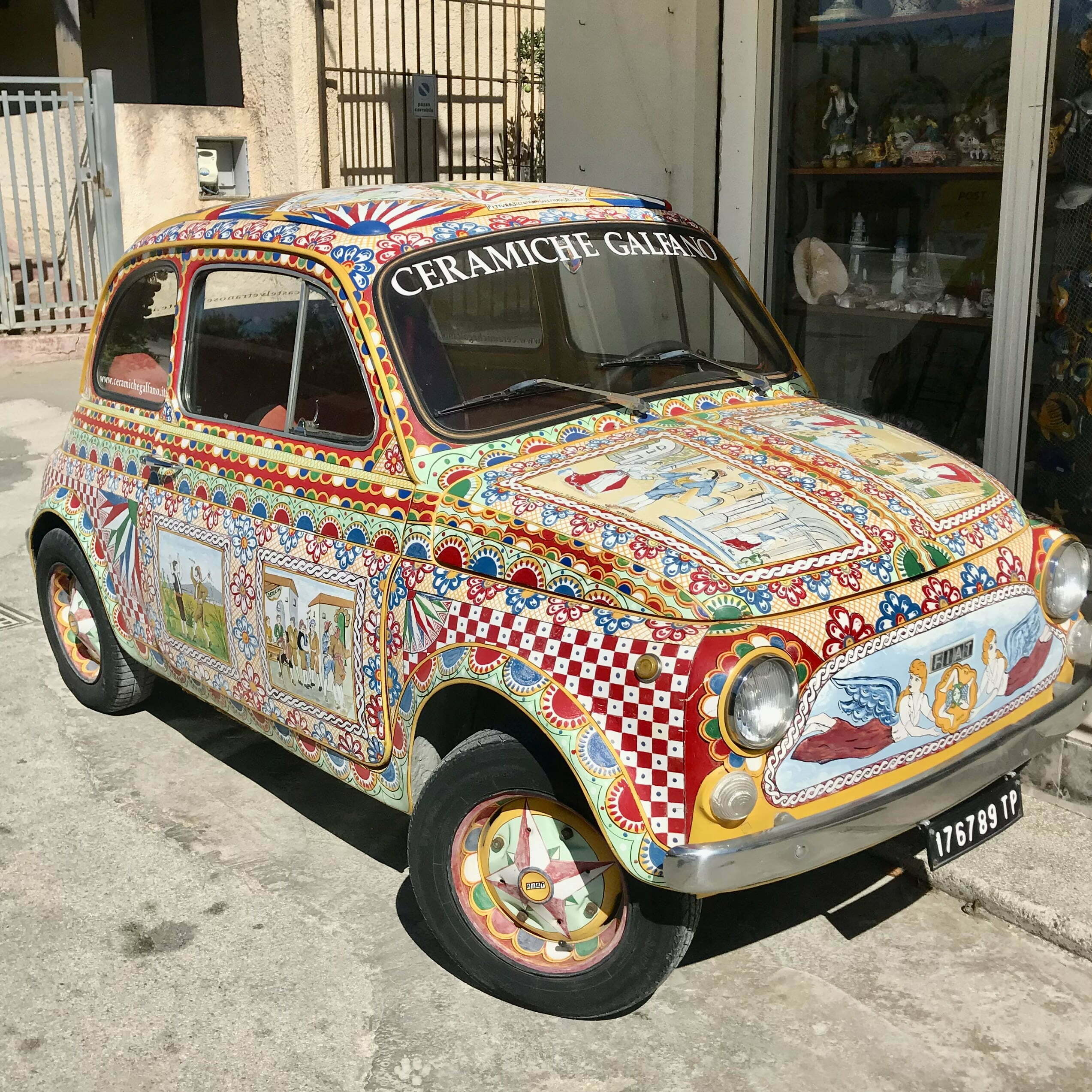FREQUENTLY ASKED QUESTIONS
&
TIPS FOR YOUR KITESURFING TRIP TO SICILY
1. Will there be wind during my dates?
2. How many hours of kitesurfing course will I do, and what will be the cost of the course?
3. How many hours do I need to learn kitesurfing?
4. How to sign up for lessons, and how does the daily planning work?
5. What does the course look like, stage by stage?
6. At what point can we talk about independence? What conditions must be met to rent equipment and ride without an instructor?
7. Kitesurfing for children – when can they start, and what do lessons for kids look like?
8. What to do when there is no wind / What are the attractions for non-kiting companions?
9. How to organize transfers or a car rental?
10. What to take for my kitesurfing trip?
11. How to travel with my kitesurfing equipment?
1. WILL THERE BE WIND DURING MY STAY?
Probably yes, that’s what we’re counting on. The kite spot was discovered and has grown over the years in this particular place, precisely because of the wind there.
We are located on the westernmost tip of Sicily, where we are mostly exposed to Tramontana, Maestro, Sirocco and Levante.
Additionally, we can also count on thermals, which increase the wind by a few knots in the period from June to September.
Wind statistics in the season are approximately 70-80% of wind days (from 12 knots up).
During a week’s stay, we can count on 4-5 days of wind, 6 or 7 are absolutely possible (and then we are lucky), while 3 days is a rare, unlucky week. Below this, it generally doesn’t happen.
There is no rule determining which months are better in terms of the number of wind days.
In months such as May or October we have more days with strong winds, than in July or August. But in the warmest months we have thermals and although days with 30 knots are rare, 14-18 knots is the norm and a classic (perfect for lessons) wind day in this period.
For us, generally the wind strength is a secondary issue (when we are talking about winds above 12 knots), because we simply choose the appropriate equipment for given conditions. What really matters is the number of wind days during which we can kitesurf.
The wind forecast gives us some insight for a few days ahead, although we treat such forecasts as indicative only.
We rely on the one-day ahead forecast. We plan our days and schedules day by day because the forecast updates every 6 hours, and we can’t plan beyond 3 or 4 updates.
If you’d like to have a real time look at our spot, and check what conditions we have at the moment, you can check it on the webcam
(under the camera image there is a Windguru wind forecast, and lower there is a weather forecast).
2. HOW MANY HOURS OF KITESURFING COURSE WILL I DO
AND WHAT WILL THE COURSE COST?
A common practice is that before your kitesurfing trip, you declare the number of hours by purchasing a specific hour package.
With us, nothing is declared or purchased in advance. We settle accounts at the end of the stay, for the hours completed.
The number of hours depends on several points.
It depends on how many of your days will be windy
Taking into account the answer to the question above, we must assume that we don’t know how many days of wind there will be during your stay.
If you come for a week and it’s windy for 4 days, the number of possible hours will be different, than if it’s windy for 6 days.
It depends on your motivation and preferred dynamics of your course
It may happen that you are on holidays with non-kiting company, and you decide to skip kitesurfing on a given day (for example for a full-day trip), even if it’s windy on that day.
Or you may choose to practice one session (generally a session lasts 2 hours) every windy day.
Finally, you may decide to make the most of the conditions, to learn as much as possible during one trip. Then you can use windy days more intensively by doing two sessions a day, with a break in between (not necessarily 2h+2h. We count every 0.5h, so you can also do e.g. 2h+1.5h or 2h+1h or 2.5h+ 1.5 hours etc.).
It depends on whether you are starting from scratch or you already have kitesurfing experience
Naturally, if you have already completed the first stages of the kite course, we will not start from scratch. We will only check what you remember, eliminate potential mistakes along the way, and move on. So the course will be shorter by the stages already completed.
It depends on whether you choose to have lessons in pair, or individually
Learning in pairs is a bit slower, especially at later stages. So naturally achieving independence will take more hours in pair classes than in individual classes.
We think that starting from scratch in pair makes sense. It’s more economical, and the first few hours of the course are almost identical in pairs and individually. You can split up at any time.
We believe that pair lessons become noticeably less effective at the stage of water starts and first tacks.
Paired lessons also make little sense when there is a significant difference in student’s levels or their weight (in this case, the more advanced or heavier person will always be disadvantaged due to the safe choice of equipment for a less advanced or lighter person).
All in all:
The number of hours depends on the wind, and what decisions you make on the go.
Assuming the most classic assumption – that you will practice individually, one regular session a day on each windy day – then, taking into account an average of 4-5 windy days per week, it would give 8-10 hours per week. Price list here.
If you assume that you don’t want to do more than X hours, and pay more than Y euros, we will make sure this is the case.
If you assume that you want to practice as much as possible, and learn as much as possible during one trip, we will intensify the course.
By default we assume: one session per day on each windy day.
3. HOW MANY HOURS DO I NEED TO LEARN KITESURFING?
Unfortunately, this is another question that can’t be answered with one word or even one sentence.
Of course, it depends on individual factors, primarily physical predispositions.
We find a correlation between the pace of learning kitesurfing and two variables:
Firstly, age. It’s a fact that kids and teenagers pick up sports faster. There’s no point in getting upset about it, just be happy that at least the kids will be done fast.
This is basically the case with all sports, and we also see this in the context of kitesurfing.
Secondly, it’s general sportiness. Practising winter sports, other water sports, other board sports or generally being in good physical shape thanks to various types of exercises – must improve the pace of learning another sport.
Anyway, it must be clearly said at this point, that kitesurfing is an egalitarian sport. Anyone can go for it and achieve full independence at their own pace.
We see women and men kiting in equal proportion, people of all ages, from children to the elderly, even those over 80.
Importantly, the answer to this question also depends on how a person interprets ‘learning’.
Some people want to feel independent as soon as possible and ride without the supervision of an instructor.
Others want to follow the course program very carefully so that they feel fully confident and comfortable with each point they check off.
And then others believe that unless they kite at a spectacular level (including more advanced acrobatics), they are not done and need progressive training.
But to not have the answer to the above question that blurry, we can assume that on average 6-10 hours of lessons with an instructor are enough to feel the first tacks. A few more hours will probably be needed to achieve the level of controlled riding, including riding upwind (what gives the ability to reach any selected point in the water with the kite, regardless of the wind direction).
4. HOW TO SIGN UP FOR KITESURFING LESSONS, AND HOW DOES THE DAILY PLANNING WORK?
Signing up for lessons:
We are a stationary school operating on site continuously throughout the season.
We start the season on the first May weekend (so in practice, we open in the last days of April) and close on the last day of October.
Everyone can visit us at any chosen date (so depending on work holidays, children’s holidays, flight prices or other individual factors).
Signing up for lessons is easy – you let us know in which dates you plan to come (by e-mail, by phone or via WhatsApp), how many people are willing to take lessons, at what stage of kite learning these people currently are, and whether there are people willing to rent the equipment (this applies only to people kiting independently, because students taking lessons don’t rent equipment – the equipment is included in the price of the course).
We don’t charge any prepayments and don’t expect a declaration as to the number of hours – we settle accounts at the end of your stay, for hours (or rentals) completed, according to the price list.
We run a calendar and we note all the bookings there.
There is no risk that there will be no instructor or equipment on site, because thanks to sign-ups we can make sure that we are not approaching the school’s capacity limits.
Daily schedule planning:
We plan our schedule day by day.
Every day in the afternoon we draft the schedule for the next day. This is the time when students tell us their possible preferences.
By default, for every windy day to come, each student is scheduled for one session (that lasts 2 hours), but sometimes there are special preferences.
For example: request for classes in the afternoon, because a trip is planned for the morning Or request that all students from a group would start lessons at the same time, because after classes there are common plans. Or there is a request for two sessions a day with a break in the middle. Or there is a request for changing the duration of the lesson to shorter or longer (we bill lessons every 0.5 hour), etc.
Usually, after the first day of lessons, students feel comfortable and confident in planning next days and verbalizing their preferences 🙂
After collecting preferences, if there are any, we analyse the updated wind forecast. Based on that, we create a schedule for the next day, and communicate it to all students (preferably via Whatsapp).
The afternoon or evening wind forecast update is usually precise enough, that we can rely on it when planning lesson times.
5. WHAT DOES THE COURSE LOOK LIKE, STAGE BY STAGE?
Briefly it looks like this:
A lesson lasts 2 hours. The first lesson (for a person starting from scratch) takes place partly on the beach and partly in the water.
First, there is a bit of theory about the wind and the wind window, about the water area and kitesurfing equipment. Then we prepare the equipment and discuss safety systems. Then we enter the water, and the practical, but still static, part of the course begins – learning to control the kite.
During next lessons, after mastering kite control, we move on to dynamic exercises. Firstly, there are the so-called body drags, so generating power with a kite (kite movements), but without a board. These are the same manoeuvres that we will later practice with the board on the feet.
In the next stage, we put on the board and, having mastered the kite and its dynamics, we try to get up on the board and ride the first meters of the tack. The goal is to stay on the board and try to get into the right position. This is the moment when you can experience the actual feeling of kitesurfing.
The instructor remains in radio communication with the student at all times, and can correct his or her posture on an ongoing basis.
The next goal is to maintain a long tack, be able to control speed and stop.
Then we move on to riding upwind in both directions.
Initially, in order to change direction, the student stops and starts a new tack in the other direction, but eventually, instead of stopping, we practice transitions.
And this is when learning to be independent ends. Of course you can continue the lessons, learn more impressive types of turns, jumps and first tricks, but you can also postpone these pleasures for later and in the meantime enjoy the possibility of independent and fully controlled riding.
All details about lessons are here: COURSES AND PRICE LIST.
6. AT WHAT POINT CAN WE TALK ABOUT INDEPENDENCE?
WHAT CONDITIONS MUST BE MET TO RENT EQUIPMENT AND RIDE WITHOUT AN INSTRUCTOR?
There are a few points to check off before you can go out to ride by yourself. Before renting equipment, we ask you (or your instructor) whether the following conditions are met.
Each of these points is valid, either in a general sense or in the context of riding in this specific kite spot, which is the bay of Lo Stagnone.
1. Upwind riding
– that is full control over your trajectory. Also with lighter winds, because upwind riding with light or borderline wind requires the most technique
– you know how to drop downwind to pass another rider
– you know when you are in fact riding upwind or not, especially with side on / side off directions
– and you know when it’s time to take your board off and walk upwind, rather than continuing to try to ride upwind when you’re actually going down.
2. Knowing the right of way and signalling your way to the person you pass
by lifting the kite a little on the windward side or lowering it slightly on the leeward side, so safe and controlled passing of other people in the water.
3. Correct kite launch – very important for safety!
– you know how lines cross over before the start and how to avoid crossing / tangling
– after entering the water (we start the kites from the water, not from the beach), you don’t unwrap the bar upwind (otherwise you position the kite in the hands of an assistant in the power zone). You unwrap the bar slightly downwind.
– after unwrapping the bar, you pull the power lines, preferably by pulling the chicken loop (not the bar, so the back lines!) and check whether the lines are not crossed
– after checking the lines and hooking in, you know how to position yourself in half wind for launching, and which hand to use to lift the kite
– when launching the kite, you don’t pull the bar – the worst accidents result from this mistake. If there is no power at launching, you pull the power lines by taking a few steps backwards/upwind, or you pull the power lines over the chicken loop with your hand.
4. Correct landing
In the water, at a safe distance from the shore (at least 2x the length of the lines). Be patient with the kite at the zenith, we will come to you.
Mind that it’s always better to start landing further from the assistant than too close. Remember to let go of the bar upon landing.
5. You can stop by edging with a board
(so the kite stays on the side), and not by launching the kite to the zenith.
Stopping by edging is a controlled way of stopping, at a chosen point. Stopping by lifting the kite results with losing the grip of the board edge and sliding uncontrollably downwind (significantly, if you go fast).
6. You always look back before turning back
and you know how much space you need around, before a jump, any manoeuvre or trick
7. You know the self-rescue procedure and what to do in the event of a collision
– you know what to do when you immediately become overpowered or when the wind suddenly drops, while you are in the middle of the bay
– you know how to release the kite and how to put it back together to continue riding
– you know what to do in the event of a collision with another rider
If you are not sure about any of the above points, you can sign up for a refresher/complementary lesson, so that you can practice and check off the above points together with the instructor, and also become more familiar with the waters of Lo Stagnone.
7. KITESURFING FOR CHILDREN – WHEN CAN THEY START, AND WHAT DO LESSONS FOR KIDS LOOK LIKE?
There are different opinions about at what age or weight it’s ok to start learning. We have so many years of experience in teaching children that we have developed our own opinion on this topic, as well as on the methodology and equipment needed.
Age, weight and mental readiness
We don’t have a strict age and weight limit, but in practice we usually start from 10/11 years old and from 25/30 kg upwards.
But it’s the kid’s internal motivation that is more important than age and weight. The kid doesn’t have to be extremely determined (although that happens), but it has to be curious and willing to try kitesurfing. In situations when a parent is stubborn and pushes the child out into the water and the child doesn’t want to, nothing good comes of it, and it’s better to wait a year or a few years, than discourage the kid for good.
Methodology and safety
As for the methodology, it’s slightly different than in the case of adults.
The younger and more distracted the kid is, the less theory, nomenclature and repetitive exercises, but more elements of fun with a sense of the dynamics and power of the kite. The kid discovers the specificity of the sport, so that kitesurfing becomes familiar.
The older or more focused and task-oriented the child is, the more the course resembles the one for adults, but with increased safety measures and equipment tailored for children.
It’s worth adding here that the Lo Stagnone spot is perfect for teaching children (and adults for the same reason) due to the fact that the water area is shallow. The kid will have ground under the feet at every point.
And just like in the case of adults, children are in constant radio communication with the instructor (which is needed from the first tacks, when the child starts riding).
Equipment tailored for children
Our equipment for children, just like for adults, is new (replaced seasonally) and safe. To teach children, we use training kites, then small closed-cell foil kites and hybrid kites (with four lines and regular depower), and in later stages, inflatable kites in the smallest sizes and bars with shortened lines.
We have harnesses, helmets, wetsuits and neoprene tops in small and microscopic sizes.
The fact is that children can go from zero to hero (so ride independently) faster than adults 🙂
Our policy on settlements for lessons is, of course, no different in the case of children than that we apply to adults – so payment at the end of the stay, for the hours that have been completed. This means that kids can try and decide for themselves, whether they want to continue or they prefer the holidays to be without kitesurfing.
More about teaching children in the article devoted to the topic.
8. WHAT TO DO WHEN THERE IS NO WIND / WHAT ARE THE ATTRACTIONS FOR NON-KITING COMPANIONS?
The Lo Stagnone spot is awesome as a kitesurfing destination not only because of the ideal conditions for practising this sport, but also because of its entire surroundings.
We are in Italy, in the cradle of civilization and culture, a place famous for its wonderful cuisine and a place so not urbanized, that we can also enjoy pristine nature.
So there are three suggestions in response to the question above:
– visit relics of the past,
– enjoy nature and the beautiful landscape,
– and pamper yourself with culinary delights.
We have collected all the details about these three pleasures HERE.
9. HOW TO ORGANIZE TRANSFERS OR CAR RENTAL?
Generally, it is not necessary to rent a car to come to Lo Stagnone.
Taxis and private shuttles run from Trapani (Birgi) airport to the spot. It’s a distance of approximately 6 km and costs 15-20 euros one way.
From Palermo airport you can get to Trapani airport by bus (here is a link to the carrier – you need to choose the Palermo Aeroporto – Trapani Aeroporto route),
or by private transfer – it’s 90 km, and the one-way transfer will be 65-90 euros (1 hour ride).
If you want to order a transfer, let us know and we will look for the cheapest solution.
Important: if you don’t plan to have a car, you should choose accommodation directly next to the spot, or within cycling distance – if you plan to rent a bike.
However, we always advise you to consider renting a car upon arrival, for several reasons:
1. There are no shops in the village of Birgi (where the Lo Stagnone spot is located), apart from one rather small shop selling basic necessities.
To the nearest proper store you will have to go to San Leonardo (4 km). You can run errands by bike, but you have to take into account a several-kilometre route in the heat, half of which with your cargo.
A large, well-stocked supermarket is 10 km from the spot.
The vast majority of useful addresses are within driving distance.
2. The choice of restaurants in the nearest area is sufficient, but rather small. There are plenty of great restaurants (which we recommend here) that you will have to drive to get to.
3. Western Sicily has a lot of fantastic places to offer on windless, non-kiting days. These don’t have to be long, all-day escapades, but within just 40-60 minutes by car we move to another world. Our self-made guide to Sicily is a compilation of such places – it’s a collection of suggestions for smaller and larger trips, but never exceeding one day.
But you can’t really do it without a car.
4. Transfer from and to the airport. As mentioned above, this issue can be solved without a car, but if you get one, there is no transfer topic, since you pick up the car at the airport.
Mind that the transfer itself (private or bus) is also a cost.
How to approach the car rental topic?
You can rent a car locally or from a rental company at the airport.
Upon request, we will send you contact details of local rental companies with whom you can negotiate and come to an agreement (also for selected, even single days of stay, and also with the possibility of delivering the car to a selected place, e.g. Trapani airport).
These local car rentals can sometimes be cheaper, but can also be comparable in price to chain rentals located at airports (especially during the high season), so we advise you to first use online comparison sites (such as Kayak, Rentalcars, Europcar) to find the best option.
You can also have a look at what Ryanair has to offer when purchasing flight tickets.
Note: Sometimes it’s worth to change the time of picking up and returning the car – it can significantly change the price.
When renting a car from an online rental company, it’s good to remember about a few things:
– you must have a credit card when picking up the car.
Sometimes rental companies don’t accept debit cards and charge additional, significant fees for not having a credit card.
– after choosing the best rental option, carefully choose the optimal insurance for you. At the time of the car pickup, firmly refuse to buy insurance extensions.
They always, always, insist on additional insurance, no matter how much you had paid for the chosen insurance, when you booked online.
– when choosing an offer, pay attention to whether the rental company is located at the terminal – so at the airport, or some distance from it.
It happens that cheaper rental companies are in some distance from the airport, and therefore you will have a short (usually free) transfer. This takes some time, but on the other hand, the savings on the car may be worth it.
– take good quality photos before you drive away, especially of any small defects, scratches.
Just in case.
10. WHAT TO TAKE FOR THE KITESURFING TRIP TO SICILY?
Guests taking kitesurfing lessons or renting equipment at Kite Lab can use all accessories at their own discretion, without any additional costs.
We have 3/2 mm wetsuits (with short or long sleeves and long legs), as well as 1.5 mm neoprene tops.
In fact, wetsuits are only useful in early spring and late autumn, neoprene tops in transitional moments and the rest of the time, so in summer, only a lycra or t-shirt will do (for sun protection).
Apart from wetsuits and neoprene tops, we provide t-shirts, leggings, impact vests and helmets.
Water shoes are not necessary
– there are no rocks at the bottom, only sand, mud or grass. It’s also easier to put on the board, as well as feel the board with your feet, without shoes. Suffice it to say that the instructors, even though they walk on the bottom all day, are usually barefoot.
But sometimes it might happen to step on a shell or small stone, so people with delicate feet will choose shoes over comfort on the board.
We don’t provide shoes. We don’t recommend thick shoes, as it’s impossible to ride in shoes with a hard, stiff sole.
Thin neoprene socks are a good solution in this case. Last time we checked, they were in Dechatlon, and we also sell those socks on site (in sizes from XS to XL).
Flip-flops, slides or sandals for the beach should be one of the first things in the suitcase.
We advise people, especially women, who have delicate or allergic skin or fair complexion to wear leggings/gaiters/yoga pants
– due to the sea weeds found here and there. These algae cause in some people a reaction similar to the reaction to nettle, so a short-lasting but irritating rash or hives (which Fenistl gel helps with). The topic rather concerns only the legs.
Wetsuits used at the beginning and end of the season cover legs and the problem doesn’t exist, but on hot days it’s too warm for a wetsuit, hence the use of leggings.
We provide leggings, so if you don’t have your own, you can always grab them at the school.
If you’re going to ride with sunglasses (recommended),
it could be a good idea to invest in the cheapest possible ones. Or get a band to hold them on your head, preferably a durable, floating and bright one.
Sunglasses that are not attached, are lost irretrievably during the first fall. Always.
In addition to the above, a waterproof sunscreen is a must.
The spot is like a frying pan, and the Sicilian sun is very aggressive.
11. HOW TO TRAVEL WITH MY KITESURFING EQUIPMENT?
It’s not a problem to travel with kite equipment, but usually it’s an additional cost.
It is best to transport kitesurfing equipment in a quiver (board bag), but if you’re not carrying a board, you can carry your kites in your regular registered luggage.
For orientation, here is how it works with Ryanair: a quiver is paid as sports luggage (€70 round-trip – purchased with the ticket, €80 – purchased later) and the weight limit is 20 kg.
At the same time, we would like to remind you that we rent this year’s new Duotone equipment in all sizes from 5 m to 17 m.

